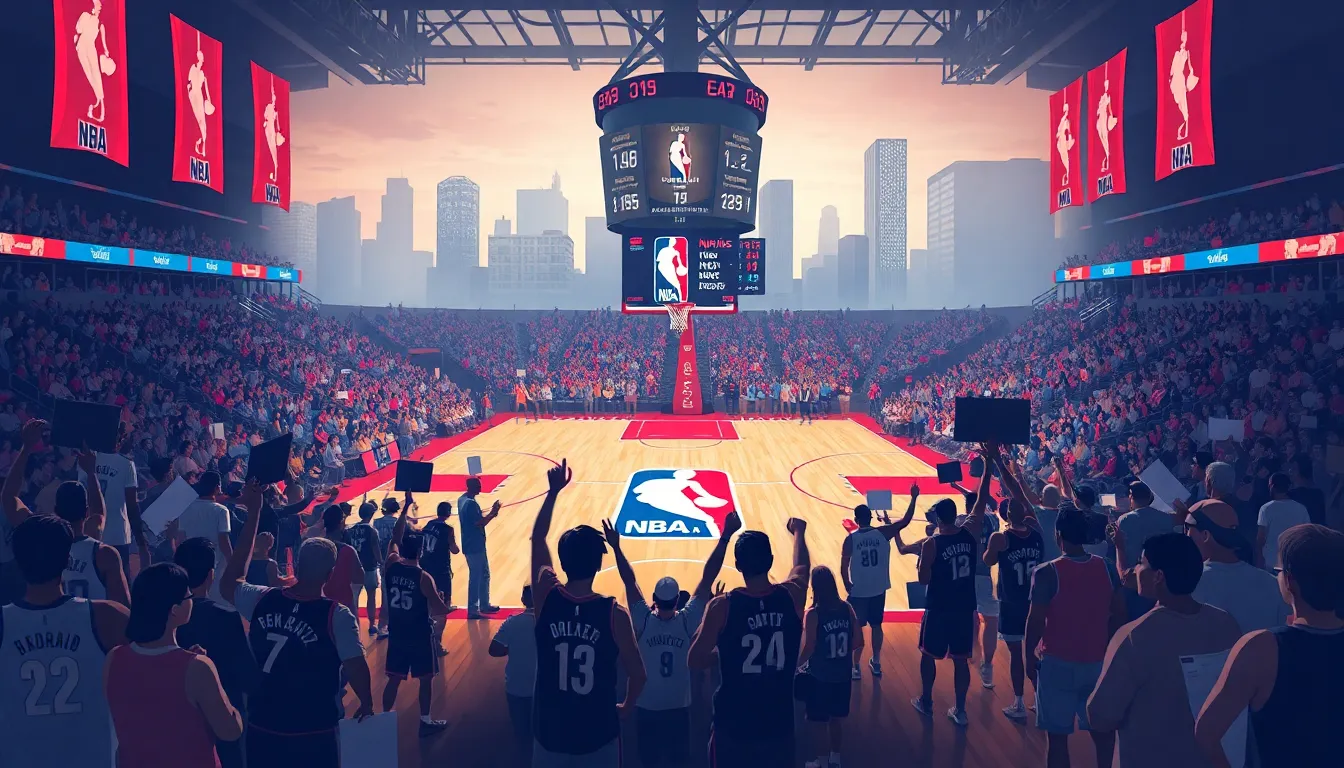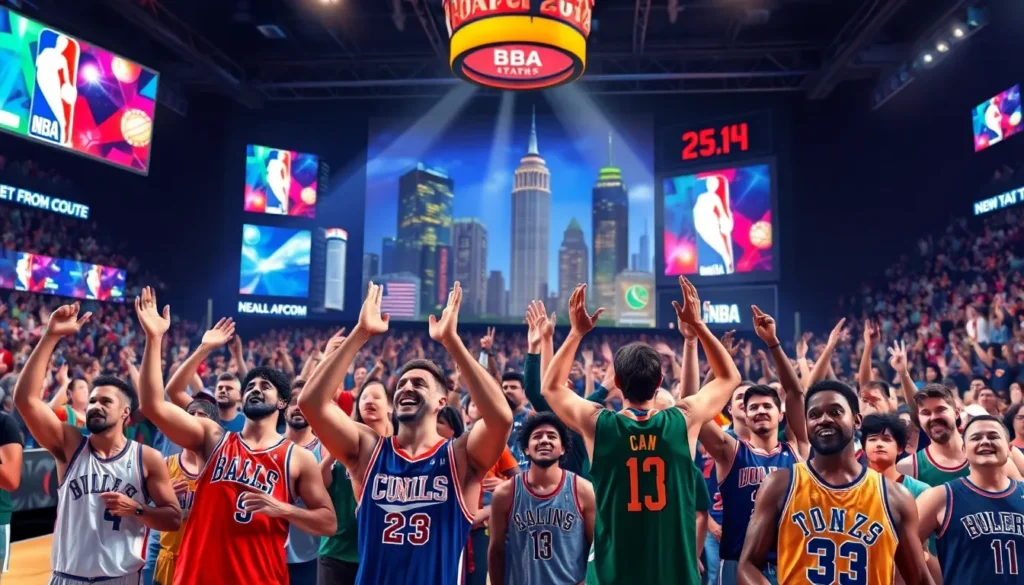The NBA is buzzing with excitement, and it’s not just from the sound of sneakers on hardwood. Expansion talks are heating up, and fans everywhere are wondering where the next franchise will land. Will it be a city that’s longed for a team or a place that’s already got a passionate fanbase?
NBA Expansion News
The NBA experiences significant interest in potential expansion. Cities like Seattle and Las Vegas show strong ambitions for new franchises due to existing fan support. Reports indicate that these locations often resonate with the league’s vision for growth. Stakeholders frequently discuss how adding teams could enhance the league’s market reach.
Strong evidence reveals that local economies may boost following an expansion. Economists noted that new franchises significantly contribute to job creation and economic development. When examining media markets, various analysts point to the advantages of increased advertising revenue and heightened visibility.
While league officials remain cautious, they’ve not ruled out expansion discussions. Press releases from the NBA and public statements from commissioners underline the priority of maintaining competitive balance. By weighing these factors, the league can prioritize cities based on infrastructure and readiness to host a team.
Fan engagement will also play a crucial role in expansion decisions. Feedback from surveys indicates a high level of enthusiasm in potential markets. Fans in cities that have long sought teams demonstrate a desire to embrace the league’s culture. Data from recent studies shows that successful franchises often emerge from areas with dedicated supporters.
Interviews with team executives suggest that ownership groups actively explore investment opportunities. Potential buyers express readiness to invest in franchises, viewing them as profitable ventures. Confidence in the NBA’s upward trajectory remains high among investors, influencing their interest in expansion possibilities.
Historical Context of NBA Expansion

NBA expansion has evolved significantly since the league’s inception. Awareness of previous expansion efforts sheds light on current discussions.
Previous Expansion Teams
The NBA introduced new teams in several landmark expansions. The 1966 addition of the Chicago Bulls marked a pivotal moment, expanding the league’s competitive landscape. In 1976, the NBA merged with the ABA, bringing in four teams including the San Antonio Spurs. This expansion broadened the league’s reach and popularity. More recently, the Charlotte Hornets rejoined in 2004, while the Toronto Raptors and Vancouver Grizzlies debuted in 1995 as the league began to tap into international markets. Each of these moves reflected strategic intentions to capture fan bases and enhance team markets, laying the groundwork for current talks about new franchises.
Impact on the League
Expansion impacts various facets of the NBA. Increased teams grow the league’s market and attract more revenue opportunities. Such growth can lead to heightened competition as talent disperses across teams. Additionally, expansion fosters local engagement, boosts economies, and promotes job creation. Franchises in new cities, for example, can stimulate interest and elevate fan participation. Historical data indicates that markets like Seattle and Las Vegas exhibit strong enthusiasm, affirming their potential for future expansion. Evaluating previous expansions highlights their role in shaping the current landscape and underlines the significance of balancing competitiveness and market demand in future decisions.
Current Expansion Discussions
Current conversations about NBA franchise expansion spark considerable interest among fans and stakeholders alike. Cities like Seattle and Las Vegas top the list of potential locations due to their existing passionate fan bases.
Potential Cities for Expansion
Seattle, with its rich basketball history, stands out as a prime candidate for a new franchise. The city’s fervent support for sports speaks volumes, evidenced by its successful WNBA team and the recent return of NHL’s Kraken. Las Vegas also attracts significant attention, hosting the NBA Summer League and showcasing strong market potential. Both cities align with the league’s growth strategy, making them favorable for prospective owners. Other cities, such as Mexico City and Nashville, may also emerge in discussions, reflecting diverse geographical interests.
Key Stakeholders Involved
Key stakeholders include current team owners, league officials, and potential investor groups. Each party navigates the complexities of expansion discussions. Current owners express concerns about competitive balance, while league executives seek growth opportunities. Investor groups increasingly show interest in the financial potential tied to new franchises. Additionally, market research companies provide valuable insights through fan engagement surveys, influencing decision-making. Overall, collaboration among these stakeholders shapes the landscape of NBA expansion discussions.
Implications of NBA Expansion
NBA expansion carries significant implications for various aspects of the league, including economic and competitive factors. High-profile discussions about new franchises can reshape local markets while addressing the balance of teams.
Economic Impact
Economic growth accompanies NBA expansion. Job creation occurs in local communities through construction, new businesses, and team operations. Each new franchise can stimulate tourism, drawing fans to games and events. Increased spending impacts local restaurants, hotels, and retail sectors, leading to broader community benefits. League officials anticipate that cities like Seattle and Las Vegas may experience substantial financial enhancement from influxes in ticket sales, sponsorships, and merchandise revenues. Historical data underscores the economic gains seen in cities hosting professional teams, highlighting just how impactful a franchise can be for local economies.
Competitive Balance
Maintaining competitive balance factors prominently in NBA expansion discussions. Concerns arise among current team owners regarding the potential dilution of talent across the league. Each new franchise could alter competitive dynamics, affecting game outcomes and league standings. League executives actively consider how to prevent disparity among teams while promoting fair competition. Strategies may include adjustments to the draft process or salary cap structures, ensuring that no team becomes too dominant. Ultimately, striking a balance between adding teams and maintaining competitive integrity remains crucial as the NBA explores expansion opportunities.
Future of the NBA Expansion
Expansion discussions shape the future of the NBA significantly. Seattle emerges as a favored candidate due to its basketball heritage and passionate fanbase. Las Vegas draws attention, benefiting from its robust market potential and NBA Summer League presence. Each city’s unique attributes present compelling reasons for inclusion.
Nashville and Mexico City also feature prominently in dialogues around expansion. Diverse geographic interests highlight the league’s aim to engage with wider demographics. Key stakeholders, including team owners and league executives, navigate this complex landscape. Concerns about competitive balance arise among current owners who fear potential talent dilution across the league.
Market researchers and surveys gather fan insights, helping steer decision-making processes. Results show that enthusiasm is high in potential markets. Local economies stand to gain from job creation and enhanced tourism associated with new franchises. Increased spending in sectors like hospitality and retail follows, providing comprehensive community benefits.
Revenue opportunities expand as new teams contribute to ticket sales, sponsorships, and merchandise. In addition, discussions about maintaining equitable competition remain ongoing. Strategies to balance these dynamics without compromising league integrity gain importance. Engagement with fan bases proves crucial for measuring interest and economic impact.
Local governments and business leaders engage in collaboration, showcasing community support for potential franchises. All involved understand that a successful expansion hinges on aligning interests of current teams with those of prospective markets. Significant shifts in NBA structure loom on the horizon, making this an exciting time for fans and stakeholders alike.
Conclusion
The NBA’s potential expansion is creating a buzz among fans and stakeholders alike. With cities like Seattle and Las Vegas leading the charge, the league stands at a pivotal moment that could redefine its landscape. The economic benefits of new franchises are clear, promising job creation and increased local engagement.
However, the challenge of maintaining competitive balance remains a priority for league officials. As discussions progress, the enthusiasm from prospective markets indicates a bright future for the NBA. The next steps in this journey will shape the league’s trajectory and fan experience for years to come.

